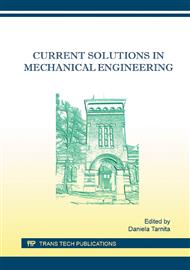[1]
M.H. Rahman, M. Saad, J.P. Kenne, P.S. Archambault, Modeling and Development of an Exoskeleton Robot for Rehabilitation of Wrist Movements, 2010 IEEE/ASME International Conference on Advanced Intelligent Mecatronics, Montreal, 2010, 25-30.
DOI: 10.1109/aim.2010.5695839
Google Scholar
[2]
S. Parasurman, A.W. Oyong, V. Ganapathy, Development of Robot Assisted Stroke Rehabilitation System of Human Upper Limb, 5th IEEE Conference on Automation Science and Engineering, Bangalore, 2009, 256-261.
DOI: 10.1109/coase.2009.5234163
Google Scholar
[3]
D. Mandru et al., A Hybrid Fes-Exoskeleton System to Rehabilitate the Upper Limb in Disabled People (EXOSLIM), Research Report, Technical University of Cluj-Napoca, (2012).
Google Scholar
[4]
F. Ozkuk, D.E. Barkana, Upper –Extremity Rehabilitation Robot RehabBoby: Methodology, Design, Usability and Validation, Int. J. Adv. Robot. Syst., 2013, vol. 10, 401: (2013).
DOI: 10.5772/57261
Google Scholar
[5]
E. Rocon, J.C. Moreno, J.A. Gallego, J.L. Pons, Wearable Robots in Rehabilitation Engineering Tremor Suppression, in T.Y. Kheng (Ed. ), Rehabilitation Engineering, Intech, 2009, 203-221.
DOI: 10.5772/7382
Google Scholar
[6]
K. Kiguchi, T. Fukuda, Upper Limb Exoskeletons for Physically Weak Persons, in S. Kommu (Ed. ), Rehabilitation Robotics, Intech, 2007, 287-299.
DOI: 10.5772/5166
Google Scholar
[7]
I. Galiana, et al., Wearable Soft Robotic Device for Post-Stroke Shoulder Rehabilitation: Identifying Misalignements, 2012 IEEE/RSJ International Conference on Intelligent Robots and Systems, Vilamoura, 2012, 317-322.
DOI: 10.1109/iros.2012.6385786
Google Scholar
[8]
S. Sargsyan, V. Arakelian, S. Briot, Robotic Rehabilitation Devices of Human Extremities: Design, Concepts and Functional Particularities, Proceedings of the 11 Biennal Conference on Engineering Systems Design and Analysis ESDA 2012, Nantes, 1-10.
DOI: 10.1115/esda2012-82322
Google Scholar
[9]
S. Noveanu, B. Chetran, M.O. Tătar, G. Răducanu, D. Mândru, Structural Synthesis of the Upper Limb Modular Wearable Exerciser, Proceedings of the 17th International Conference on System Theory, Control and Computing (ICSTCC-2013), Sinaia, Romania, 2013, pp.693-697.
DOI: 10.1109/icstcc.2013.6689041
Google Scholar
[10]
O. Tătar, D. Mândru, S. Noveanu, B. Chetran, The kinematic model of 3 DOF rehabilitation robotic exosckeletons, Robotica & Management, vol. 18, nr. 2, 2013, pag. 26-31.
Google Scholar
[11]
B. Chetran, O. Tatar, S. Noveanu, D. Mândru, A Proposal for a Driving System of a Four DOF Rehabilitation Exoskeleton, Proc. of Meditech 2014, IFMBE Proc., Vol. 44, pp.7-10, (2014).
DOI: 10.1007/978-3-319-07653-9_2
Google Scholar
[12]
B. Chetran, S. Noveanu, O. Tatar, D. Mândru, A Study of Suitable Resistive Torque Mechanisms for Rehabilitation Exoskeletons, Proc. of 2014 Int. Conf. on Electrical and Power Eng. Iasi 2014, IEEE Catalog Number CFP1447S-USB.
DOI: 10.1109/icepe.2014.6969892
Google Scholar


